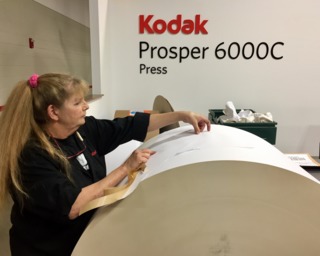Getting into Production Inkjet: What to Buy, and When to Buy It
New production inkjet technologies continue to emerge. So, when is the right time to upgrade, and what is the best investment?

There comes a time when every successful print service provider (PSP) begins to outgrow its production environment. However, with new technologies hitting the market left and right, the question remains: when is the best time to upgrade, and what type of investment should a shop make?
If the market research bears out, now might be the right time, and a production inkjet may just be the right choice.
In fact, according to Smithers Pira, inkjet print sales are predicted to grow at a rate of 8.2 percent annually to reach $91.5 billion by 2021.
“PSPs should consider purchasing a production inkjet device if their volume range is simultaneously too high for traditional toner, yet too low for offset,” said Eric Hawkinson, vice president, marketing, production print solutions for Canon Solutions America. “PSPs should consider the value-added benefits of production inkjet, like 1:1 personalized communications, which offset cannot provide. Inkjet can also streamline workflows and provide the ability to dynamically print customized documents inline – something which can be done easier and more cost effectively than with toner.”
Mike Herald, director of inkjet solutions, commercial & industrial printing business group for Ricoh, adds that the decision to upgrade should take several factors into consideration.
“There are two types of customers,” he said. “One type is a net-new customer who is yet to launch into the inkjet world. The other is one who is looking at the next step.”
Either way, Herald recommends considering future needs for both capacity and capability. “Capacity is about whether you have the ability to do the work you are already getting in-house,” he said. “Capability is about growing the market segments you are serving – or getting into new segments.”
According to Will Mansfield, director of worldwide product marketing & category management for Kodak’s enterprise inkjet systems division, if a PSP is a heat-set web press shop, investing in an inkjet press may allow jobs to be migrated off the web press for short-run, segmented, and even personalized work.
“This often results in cost savings by reducing paper waste, slashing production time, and eliminating plates,” he said. “They can also capitalize on revenue growth through new sales opportunities.”
“Each PSP is different,” says Hawkinson. “Their needs are different, and their workflows are different. Production inkjet provides maximum flexibility and the ability to configure a press with the exact right workflow and inline finishing requirements to support each unique business. Many of our customers have found that they have been able to eliminate the footprint of multiple presses by moving more work to an inkjet press.”
When it comes to pursuing inkjet markets, Mansfield sees a breadth of growth opportunities. “Going forward, we can expect to see PSPs serve customers with a wider range of print applications that feature greater ink coverage, glossy papers, and increased print quality overall,” he said. “Glossy direct mail self-mailers, postcards, brochures, magazines, and catalogs, to name a few.”
Herald points to healthcare applications and direct marketing as segments to target. “The advantage you get with inkjet technology today is that you can customize prints for customers in a short period of time,” he said. “The feed today is much better, the quality is excellent, and newer, better media types are available in the marketplace.”
Selecting an Inkjet
Once a PSP has decided to make the investment, there are many questions to ask manufacturers, says Hawkinson. He advises PSPs to benchmark specifications ranging from color gamut and substrate support to finishing needs, machine flexibility, uptime, and total cost of ownership.
“PSPs should also ask what other options the manufacturer has to support their business needs,” he said. “What professional services are available, what training do they provide, what is their service reputation, and what partnerships do they have with workflow and finishing companies?”
Herald emphasizes the importance of aligning the investment with a shop’s long-term business strategy. “Is it print quality that is important, throughput, media compatibility – or a solution that fits well into your environment?” he said. “Look at the kind of assistance available from the company’s internal sales force as well.”
Jason Elliott, vice president of sales for manroland web systems, advises shops to ensure they are getting all the tools they need to automate and optimize the production workflow.
“Many PSPs, especially early adopters, went into digital production thinking they would figure out the workflow as they grew the business,” he said. “This has often resulted in customized solutions of various applications and plugins that don’t provide the flexibility needed for an efficient and future-proofed production workflow.”
Know Your Inks
Before making a decision, Mansfield recommends gaining a thorough understanding of ink technologies, including their limitations.
“The inks for a high-speed inkjet printing system must be matched to the inkjet writing system,” he said. “Different writing systems require different ink formulations. For example, piezo drop-on-demand writing systems require higher amounts of wetting agents (e.g. humectants) in their inks. These wetting agents make it difficult – if not impossible – to print and dry high ink coverage jobs, especially on coated or glossy papers.”
Hawkinson notes that ink technology is evolving and progressing rapidly for production inkjet presses. “The ultimate goal is to be able to print on a wide variety of substrates, including inkjet coated, uncoated, gloss, offset commodity stocks, and more,” he said.
Media Matters
The good news for PSPs, says Hawkinson, is that inkjet media is constantly improving. “There continues to be a strong commitment from manufacturers and paper mills to collaborate and bring even more media options to market for inkjet,” he said.
Mansfield sees the increase in inkjet-compatible media as a significant factor driving adoption of the platform. “New paper companies are entering the market, and those that have been in the inkjet market are expanding their lines with new products and expanded basis weight ranges,” he said. “This increased selection is allowing more pages to move from analog (offset) printing to digital (inkjet) methods.”
Finishing Touches
Finishing equipment also plays a significant role in product quality, says Mansfield, and is an important consideration for PSPs.
“Finishing equipment is a key, but often overlooked, factor in realizing the potential of a high-speed inkjet production system,” he said. “When it comes to new options, multi-cut and variable-length sheeters are enabling greater automation and lower manufacturing costs.”
Elliott agrees. “The finishing line is an area that shouldn’t be underestimated during the purchasing process,” he said. “Depending on the scope, the right finishing line can cost as much as the print engine itself. However, the payback of choosing the right solution is much greater as it has a significant impact on your manufacturing costs.”
According to Lance Martin, vice president of national accounts for MBO America, flexible finishing is an essential component of the production inkjet workflow, especially as the industry moves increasingly toward shorter runs, faster turnarounds, and custom products.
“Building flexibility into a finishing system means decreasing the number of times a piece needs to be touched during the finishing process,” he said. “Fewer touches mean fewer opportunities for error.”
He adds that today’s brands see value in finishing techniques such as die cutting, foil stamping, and variable data, processes that older production methods cannot accommodate without major additional investments.
“Modernized printers have the potential to produce almost anything in a two-stage process – by loading the job on press with no further touches until it is a fully printed roll, and then completing all remaining steps in one pass through a modular finishing line,” said Martin. “Consolidating processes in this way minimizes touches and lets printers create unique systems that meet customer demands in true 1:1 fashion. A flexible postpress system can align and realign equipment as needed, customizing finishing routines and doing away with redundant touches.”
Inkjet’s Staying Power
With so many advancements shaping the industry today, what does the future hold?
“Faster, better, cheaper,” said Mansfield. “At Kodak we’ve set our sights on converting the traditional analog printing process to inkjet. To accomplish this, we will continue to drive for faster production, better quality, and lower total cost of production.”
Elliott tells PSPs to explore all options available to them. “Be bold in your approach to digital manufacturing,” he said. “History shows that shortcuts in scope or investment do not support the required return on investment – or position you to springboard your digital platform.”
Hawkinson adds, “A few years ago, inkjet was the new technology, and everyone wondered where it would go. Now it is a proven technology, and industry analysts agree that it is the future of print. What’s more important is that our customers have shown significant growth and success with their inkjet presses. Now is definitely the time to consider an inkjet investment – don’t wait.”



